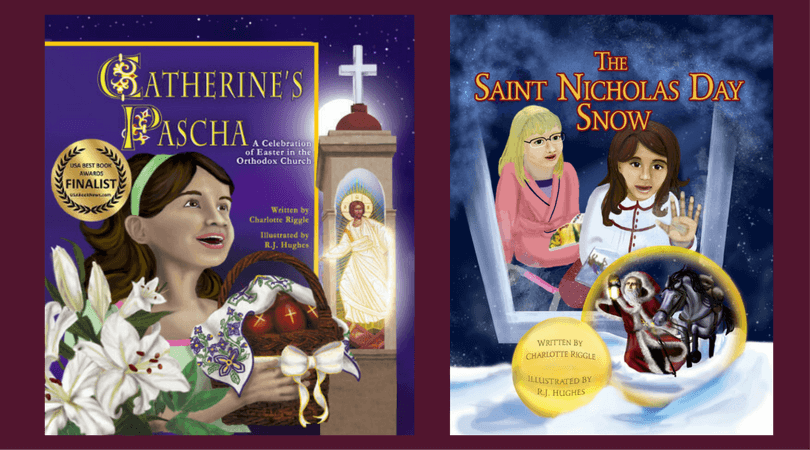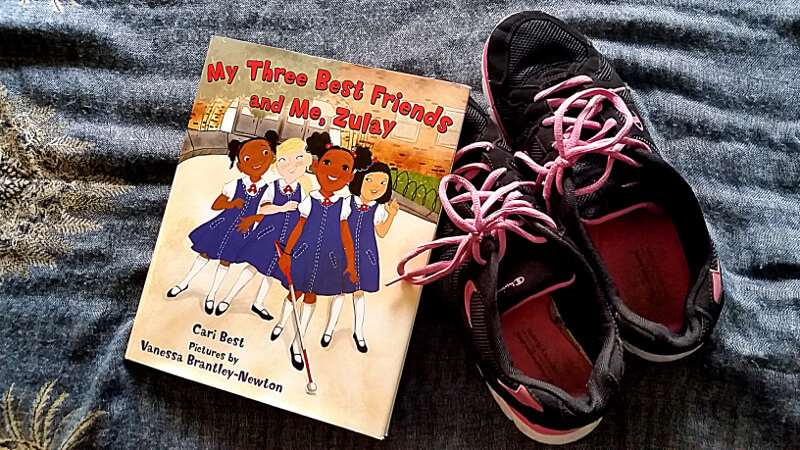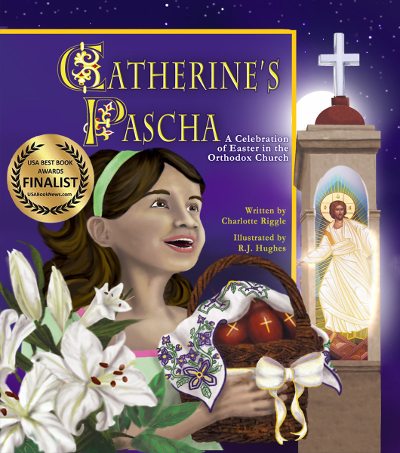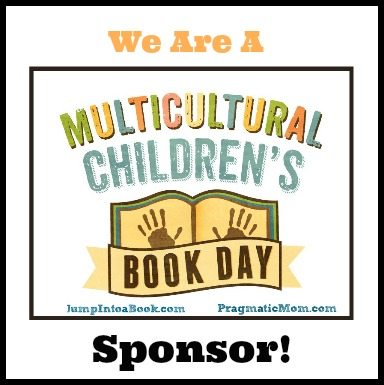Wow. Just wow. My Three Best Friends and Me, Zulay is so wonderful, so amazing, I hardly know where to begin.
So let’s begin with Zulay. Zulay is a cheerful, bouncy, friendly girl who is in the first grade. When she tells you what’s going on around her, she talks about what she hears and what she smells. That’s because she can’t see. Zulay is blind.
But she doesn’t mention that in the story. Why would she? She knows she’s blind. And, for the most part, she’s like any other student in the class. She sings. She talks when she ought to be quiet. She helps her friends, and gets help from her friends.
But when it’s time to go to gym, she’s not like everyone else. At gym time, she goes with Ms. Turner, the orientation and mobility instructor who is teaching Zulay how to use her white cane. And Zulay doesn’t like that. Not at all.
Until her teacher announces that track and field day is coming. And Zulay wants to wear her pink sneakers and run in a race. To do that, she’s going to have to get to know the track. And that means she has to learn how to use her cane.
When things are hard
Zulay is the most realistic disabled child I’ve yet met in a picture book. Zulay is happy, and she’s competent. She can wash and peel carrots. She can teach her friend to understand ones and tens. She can sing and dance. She can find her way around the school with no trouble at all.
She has trouble, though, when something makes her stick out “like a car alarm in the night waking everybody up.” She doesn’t want to stick out.
At least that’s what she says. And that’s what she thinks is true. But writing with a Brailler doesn’t bother her in the least. In fact, she’s happy to let her friends take turns trying to use it, and trying to read braille.
What really bothers her is when something is hard. “Reading used to be hard before my hands learned the way. So was climbing a tree – and swimming. Because in the beginning, all I did was fall. And sink. And not want to do it like I don’t want to do that cane.”
She doesn’t want to do the cane. She doesn’t want her friends to be interested in it. She doesn’t want to work with Ms. Turner on it. In fact, one day when it was time to work with the cane, she shouted NO and refused.
Maybe your kids never refused to try out tools and techniques that would make their lives easier. Maybe they never resented their pull-out times with the OT or the SLP. Mine did.
Zulay’s struggle with feeling incompetent will help children (disabled or not) realize that they’re not the only ones who feel that way. Seeing the utterly delightful Zulay react with frustration shows them how normal that response is. And it helps them remember that the frustration they feel is only temporary. They’ll learn the skills they need, and those new skills will help them fly.
The story behind the story
Zulay may seem so real because author Cari Best based her on a real child she met at a New York City public school. The girl was a first-grader who was blind, and who ran a race wearing pink sneakers. Just like Zulay.
That’s probably why Zulay is such a real, well-rounded character. So many books with disabled characters are about the disabililty. But My Three Best Friends and Me, Zulay isn’t about Zulay’s disability. It’s about Zulay.
Her disability isn’t ignored. In fact, her blindness is absolutely integral to the story. But it never takes over the story. It never takes center stage. Center stage is always held by the indomitable Zulay.
The art!
Did I mention the fabulous illustrations by Vanessa Brantley-Newton? They’re as bright and cheerful as they can be. They match the tone of the story, and Zulay’s winsome personality, just perfectly.
If you use this link to get a copy of My Three Best Friends and Me, Zulay, I’ll receive a small commission that helps support this website.
Read More
Looking out for Sarah: A day in the life of a guide dog: Sarah is a real person. Her story is told from the point of view of her guide dog.
The best picture books with disabled characters: Children who do not have disabilities need books with disabled characters just as much as disabled children do. And this list will help you find some terrific books for the children you love.
Disabilities and Special Needs in the Church: Have you noticed how few people with disabilities attend church? These resources will help you start taking down the barriers that keep them away.
Buy the Books!

These delightfully diverse books provide disability representation (Elizabeth, one of the main characters, is an ambulatory wheelchair user). They also give Orthodox Christian children the rare opportunity to see themselves in books, and children who are not Orthodox the chance to see cultural practices they may not be familiar with.
Catherine’s Pascha
FINALIST IN THE 2015 USA BEST BOOK AWARDS
Catherine doesn’t like vegetables. She doesn’t like naps. She doesn’t like it when her mom combs her hair. She loves hot dogs, chocolate cake, and her best friend, Elizabeth. Most of all, she loves Pascha! Pascha, the Orthodox Christian Easter, is celebrated in the middle of the night, with processions and candles and bells and singing. And Catherine insists that she’s not a bit sleepy.
Celebrate the joy of Pascha through the magic of a book: Catherine’s Pascha. Available on Amazon, Bookshop.org, and my webstore.
The Saint Nicholas Day Snow
Shoes or stockings? Horse or sleigh? Does St. Nicholas visit on December 6 or on Christmas Eve? Will a little girl’s prayer be answered? When Elizabeth has to stay at Catherine’s house, she’s worried about her grandmother, and worried that St. Nicholas won’t find her. The grownups, though, are worried about snow.
Celebrate the wonder of St. Nicholas Day through the magic of a book: The Saint Nicholas Day Snow. Available on Amazon, Bookshop.org, or my webstore.



